20 de November de 2023
Soccer Tests You Need to Assess Your Players
Soccer Tests Are Diverse And Complex
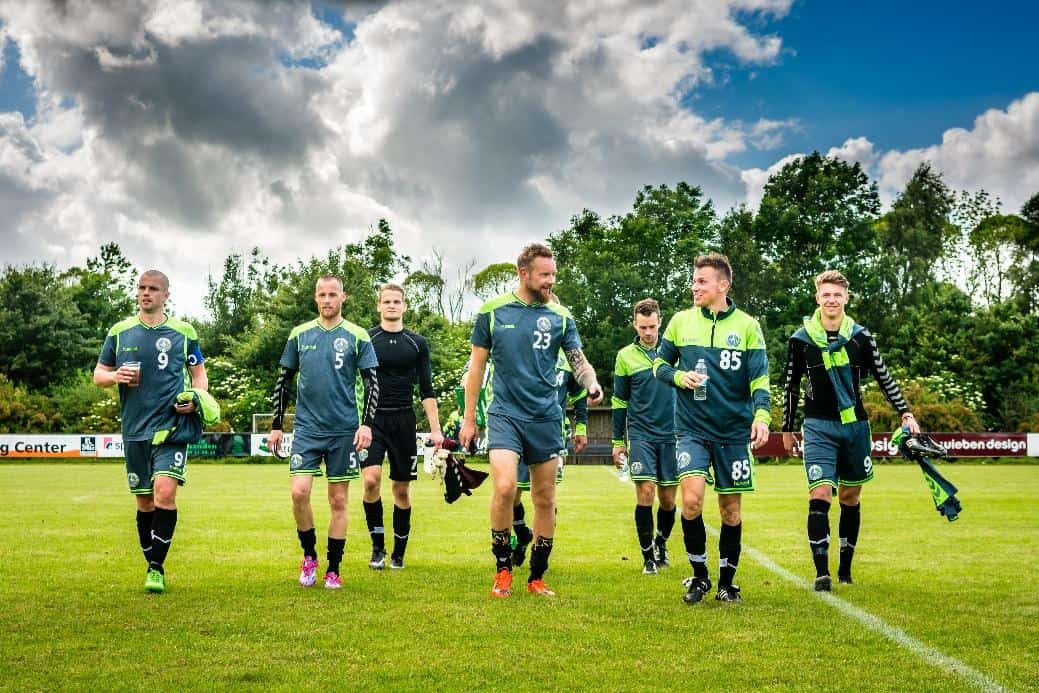
Soccer is a highly complex sport influenced by many factors beyond the physical, such as the psychological, tactical, and technical aspects (Stølen et al., 2005). There are tests for soccer and other disciplines to measure each of these factors. In this article, we will focus on physical tests. Soccer tests can be conducted in a laboratory or on the field, with both options having advantages and disadvantages.
Laboratory tests provide a useful indication of the overall physical condition of players but require expensive equipment and a significant amount of time. This is why they are only conducted in elite teams at certain times, such as at the beginning and end of the preseason, to assess the effectiveness of training and how each player starts the season.
Field tests provide sport-specific results and are therefore more valid than laboratory tests. The reduced cost, minimal equipment use, and ease of conducting soccer tests make them more convenient for use throughout the entire season (Svensson & Drust, 2005). These tests give a general physical indication and, depending on the test used, provide more specific details about soccer. However, these data only serve to monitor changes in physical condition and prescribe training more accurately due to the complex nature of soccer.
There is no single test capable of measuring all determinants of physical performance in soccer simultaneously. Physical evaluations have typically focused on measuring one or two physical components of the soccer game. Therefore, it is crucial to choose what we want to measure and the test to do so to optimize energy and time. Through soccer tests, we can create individual profiles that show strengths and weaknesses, allowing us to work with each player specifically. These tests also evaluate the results achieved through training and other factors that determine fatigue and possible injury for an athlete.
In the battery of soccer tests that we need to evaluate our players, we should include those that gather data on the most important performance indicators in this sport. To determine what these indicators are, there are the so-called Key Performance Indicators (KPIs), which are quantifiable measures used to assess the overall team success and the performance of each player individually (Herold et al., 2021). Elite soccer clubs have a dedicated team responsible for measuring these KPIs because they are crucial elements in winning matches.
Reasons For Assessing Physical Fitness in Soccer
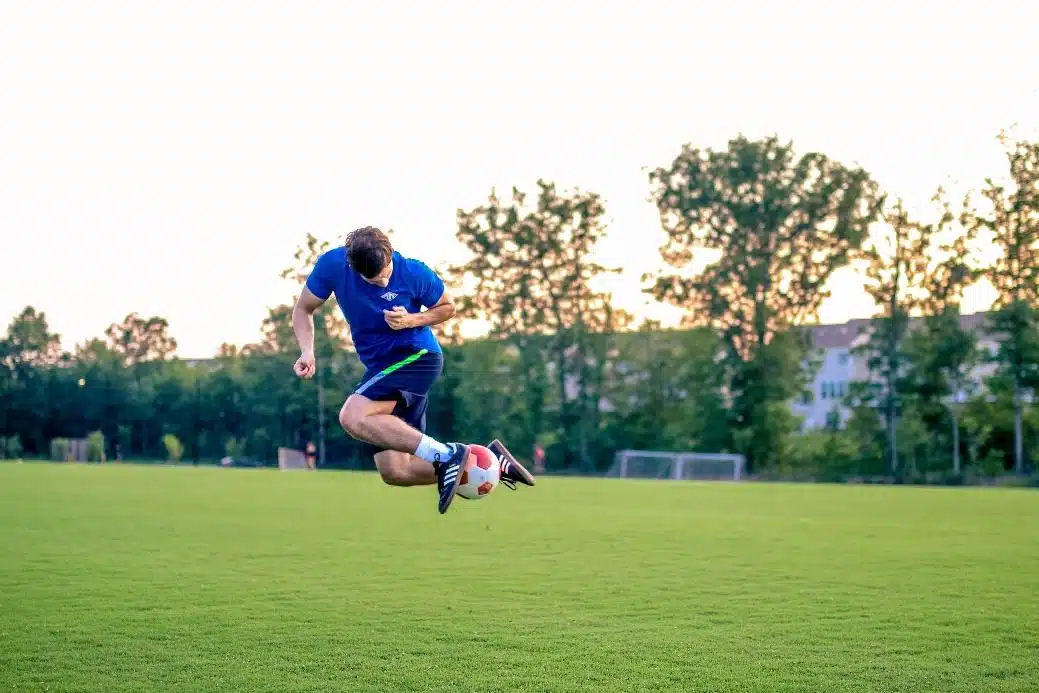
Carling, Reilly, and Williams outline in their manual ‘Performance Assessment for Field Sports’ the reasons why it is necessary to monitor the fitness level of our soccer players (Carling et al., 2009):
- To establish a baseline profile for each player and the team as a whole.
- Identify individual strengths (to capitalize on) and weaknesses (to improve).
- Provide feedback to players about their own capabilities and act ergogenically, influencing their motivation to improve.
- Objectively evaluate the effectiveness of a specific training intervention in terms of progress (improvement or lack thereof).
- Objectively evaluate the effectiveness of other training-related interventions, such as a nutritional or psychological development program.
- Monitor progress during rehabilitation or determine if an athlete is ready to complete it.
- Identify a relationship between individual performance capabilities and the actual demands of competition.
- Monitor the health status of a player.
- Assist in identifying talented soccer players.
- Attempt to create performance standards based on age category, developmental stage, special populations, playing position, and sport.
- Track and evaluate the progression of youth players.
- Place players in an appropriate training group.
- Examine performance evolution from year to year.
- Allow predictions of future performance.
- Provide data for scientific research on performance limitations.
Understanding Why Physical Tests In Soccer Do Not Solely Determine The Outcome Of A Match
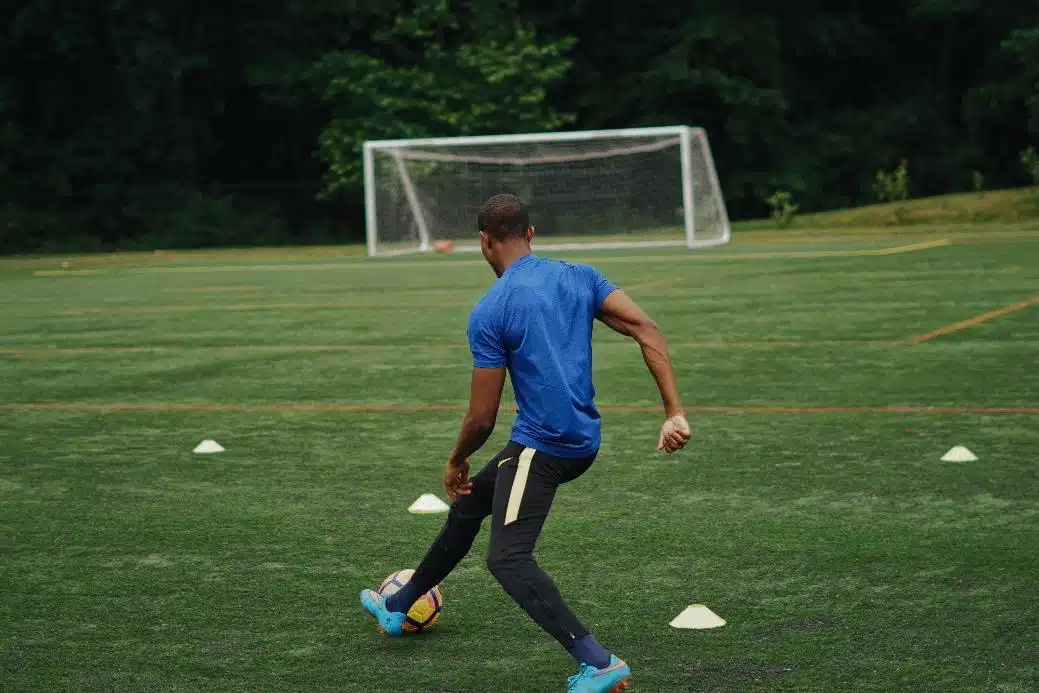
In the first section, we mentioned what Key Performance Indicators (KPIs) are, emphasizing that they go beyond the physical aspect. In soccer, a team may jump higher than another, but that doesn’t guarantee a win. However, if we have that data, the coach can choose to focus on frequent aerial balls. Technical-tactical KPIs in soccer are diverse, ranging from the number of successful passes in certain parts of the field to aspects such as the number of times the defensive line is broken with a pass behind.
Technological advancements now allow us to obtain more data than we can process, providing key values such as predicting goals based on where the ball is received (Goes et al., 2019). Some coaches place greater importance on physical fitness, while others consider it less significant, and both perspectives are valid. In the technical and tactical aspect, different key performance indicators will either bring us closer to or distance us from sporting success. A coach emphasizing physical fitness does so because a player’s strength, agility, or endurance can influence several of these KPIs, such as successfully or unsuccessfully completing a pass in the final minutes of a match.
On the other hand, a coach who places less emphasis on the physical aspect focuses on exercises to improve those passes without delving into whether fatigue plays a role. Physical load is increasingly important in soccer and any sport, both for performance and injury prevention. Consequently, the number of coaches evaluating and enhancing the physical aspects of their players is growing.
Some Technical and Tactical KPIs in Soccer
Although it is not the objective of this article, the following tables present what the key performance indicators are in soccer (Herold et al., 2021). As mentioned earlier, the physical condition of the soccer player can affect these and other KPIs, thus influencing to a greater or lesser extent these aspects of the game
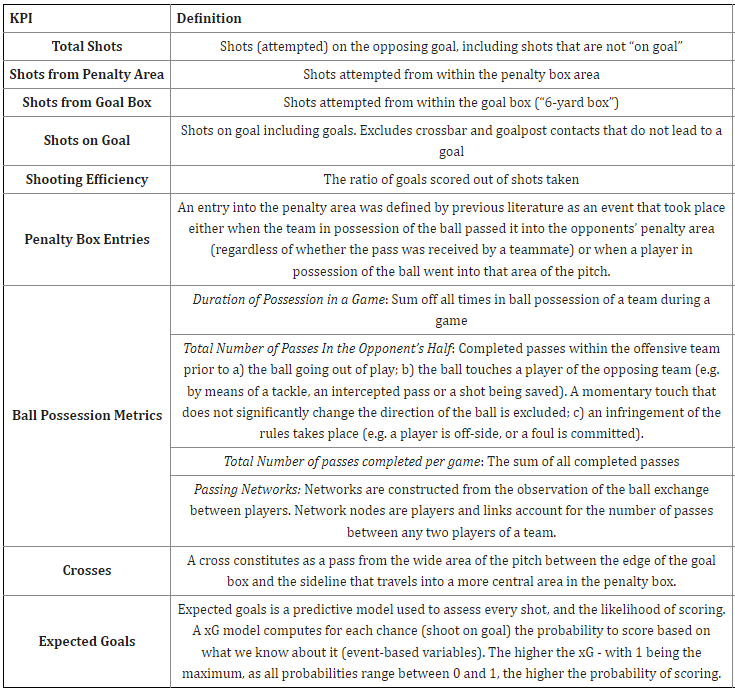
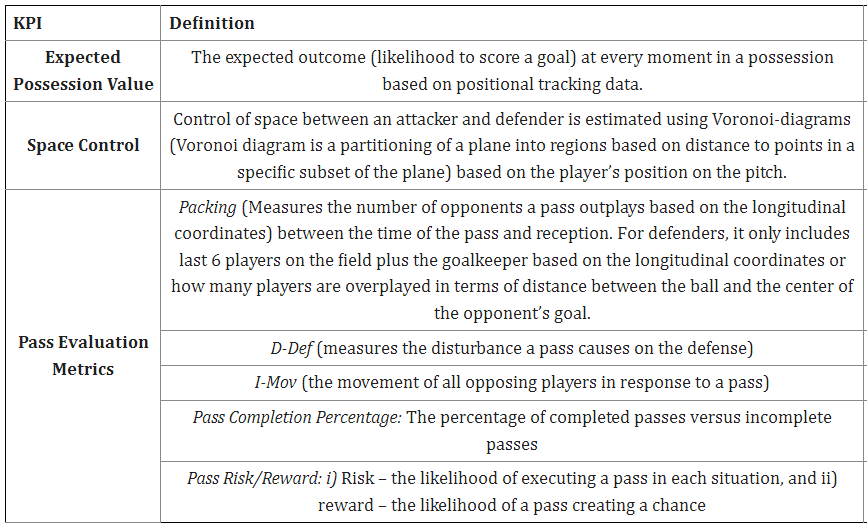
Tabla extraída de (Herold et al., 2021)
The Physical Tests in Soccer Should Evaluate These Key Performance Indicators (KPIs)
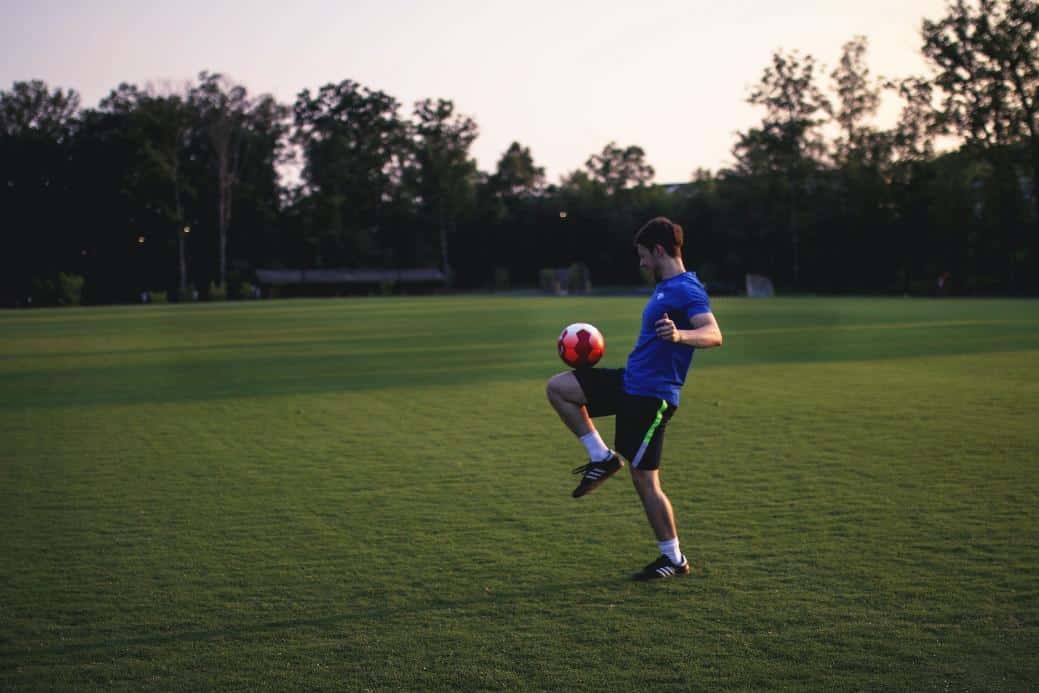
There are countless physical tests to measure basic qualities such as strength or endurance. This makes it challenging to choose the right one, especially for an elite team where every effort must be carefully considered, or for an amateur team with limited training time and no room for waste. In soccer, players run an average of 10-13 kilometers per game (Bradley et al., 2009), but this is not done in a linear or continuous manner. Within that distance, there are sprints of maximum intensity, walks at minimal intensity, jumps, collisions, and changes of direction (approximately 1,200 to 1,400 changes of direction per game) (J. Bangsbo, 1992; Little & Williams, 2005).
Heading is another important aspect of the game, whether to win a ball or score a goal. In a sample of 271 professional players competing in the Norwegian soccer league, 7.8% head the ball more than 20 times per game, and 37.1% head the ball between 6 and 10 times (Straume-Naesheim et al., 2005). Although we have mentioned that the success of a soccer player depends not only on the physical aspect but also on the psychological, tactical, and technical aspects, physical condition may affect the others. An example of this is the association between aerobic fitness and greater success in passes (Rampinini et al., 2008), which is logical because fatigue leads to more mistakes. This is evident in the reduction in pass accuracy in the final stages of each half, reaching up to 60% in the late stages of the game (Rampinini et al., 2008).
The fundamental reason why we should conduct soccer tests on our players is that scientific literature has found an association between top positions in the standings and improved physical qualities, including higher aerobic capacity (Wisløff et al., 1998), greater strength in back squats (Wisløff et al., 1998), higher repeat sprint ability (Rampinini et al., 2009), and better performance in jump tests (Arnason et al., 2004). Measuring these physical qualities will not make our athletes better simply by measuring them, but they will help us determine what to train and how to do it. If we improve these physical abilities, it may, and only may, result in better on-field performance from the players.
Soccer Tests To Measure Physical Endurance
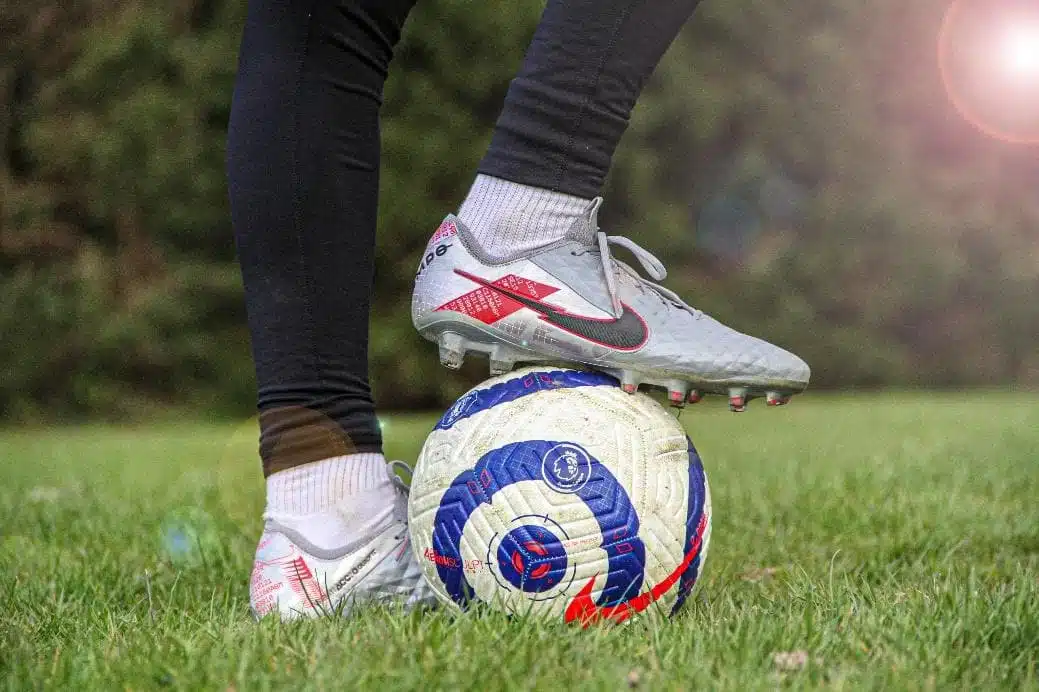
During a soccer match, the typical distance covered by an elite player is 10 to 13 km, most of which is done through walking or at low intensity (J. Bangsbo et al., 2006). This aerobic base is interspersed with high-intensity activities, including accelerations, sprints, changes of direction, jumps, lateral movements, tackles, and game-specific technical skills (Ekblom, 1986). These periods of high intensity are not only the most exciting moments in a soccer match but also the most decisive ones (Wisløff et al., 1998).
When a coach hears the words ‘test’ and ‘endurance’ together, they immediately think of maximal oxygen consumption (VO2max), as it is the gold standard and the most important measure of aerobic capacity. The VO2max in male international soccer players ranges between 50 and 75 ml kg min -1 (Stølen et al., 2005), supporting the view that aerobic energy significantly contributes to soccer performance. In fact, Bangsbo described how approximately 90% of the total energy during a soccer match comes from aerobic metabolism (J. Bangsbo, 2003). Therefore, determining a player’s maximum aerobic capacity is crucial.
The way to do this should resemble soccer as closely as possible, so it should not be continuous or linear but should include changes in speed and direction. The ability to perform repeated bouts of high-intensity exercise intermittently is fundamental in soccer. That’s why, while laboratory tests can precisely tell us each player’s VO2max and thresholds, these results are not entirely conclusive in soccer. Elite soccer matches are characterized by intermittent high-intensity activity, and so should be the soccer tests that assess the endurance component.
Loughborough Intermittent Shuttle Run Test (LIST)
This soccer test was designed to simulate activity patterns in a match (Nicholas et al., 2000). It involves running between two lines separated by 20 meters at various speeds based on the player’s VO2max. The intensity is guided by audio signals designed for the test. The test consists of two parts: Part A and Part B. Part A is a predetermined pattern of high-intensity intermittent running for 15 minutes, and Part B is an open intermittent run designed to fatigue the participant in 10 minutes.
In total, five 15-minute activity blocks, each separated by 3 minutes of recovery, make up Part A. Part A involves 3 shuttle runs of 20 meters at a walking pace, 1 × 20 meters at maximum sprint speed, 4 seconds of recovery, 3 × 20 meters at 55% of individual VO2max, and 3 × 20 meters at 95% of individual VO2max. You can see how it is precisely performed in this link.
Multi-stage Shuttle Run Test
Example:
The Multi-stage Shuttle test involves running back and forth between two lines separated by 20 meters, with speed increments every minute regulated by audio beeps from a recorder (Ramsbottom et al., 1988). The participant must reach the shuttle’s end line with each beep. If the participant fails to reach the end line once warned, and if in two consecutive shuttles, they cannot make it to the line, the test is concluded, with the total number of completed shuttles typically used as the test score. The test starts at about 8 km/h. VO2max is estimated based on the distance covered at the end of the test using the regression equation VO2max = (5.857 × speed in the last stage) – 19.458.
Yo-Yo IR1 y Yo-Yo IR2
Example Yo-Yo IR1
Example Yo-Yo IR2
The Yo-Yo tests are the most widely used field tests in soccer as they provide insights into the player’s aerobic state and their ability to recover from repeated intense exercises. Football involves performing high-intensity activities and recovering for the next one, making these tests a great option for assessing player performance. The Yo-Yo tests involve two 20-meter shuttles interspersed with 10 seconds of active recovery, with speed increments regulated by audio signals. Participants continue until they can no longer maintain the speed dictated by the audio signals, and the distance covered at that point is the test result (J. Bangsbo et al., 2008; Castagna et al., 2005).
Yo-Yo IR1 starts at a lower speed (10 km/h) than Yo-Yo IR2 (13 km/h) with lighter speed increments. Yo-Yo IR1 assesses an individual’s ability to repeatedly perform aerobic exercise leading to maximal activation of the aerobic system, while Yo-Yo IR2 focuses on the ability to recover from repeated high-intensity exercises with a significant anaerobic contribution alongside a substantial aerobic component (J. Bangsbo et al., 2008). In untrained participants, Yo-Yo IR1 elicits this physiological response. In trained participants, Yo-Yo IR1 typically lasts between 15 and 20 minutes, while Yo-Yo IR2 lasts between 5 and 15 minutes. Consequently, Yo-Yo IR1 has been reported to be more suitable for recreational players, while Yo-Yo IR2 is more applicable to trained subjects (J. Bangsbo et al., 2008).
You may also find interesting this Ultimate Guide of Velocity Based Training!
Hoff Test
Unlike the previous tests, the Hoff test introduces soccer into the test to make it even more specific (Zagatto et al., 2016). The issue with these tests, as well as others like the Foote-Val test, is that the test is influenced by ball control and other actions such as jumping over hurdles. Additionally, elements like hitting a board with the ball can result in losing possession. While the idea is good since soccer involves the ball, it may not be the most suitable for measuring endurance performance. You can see how to execute it in detail in this link.
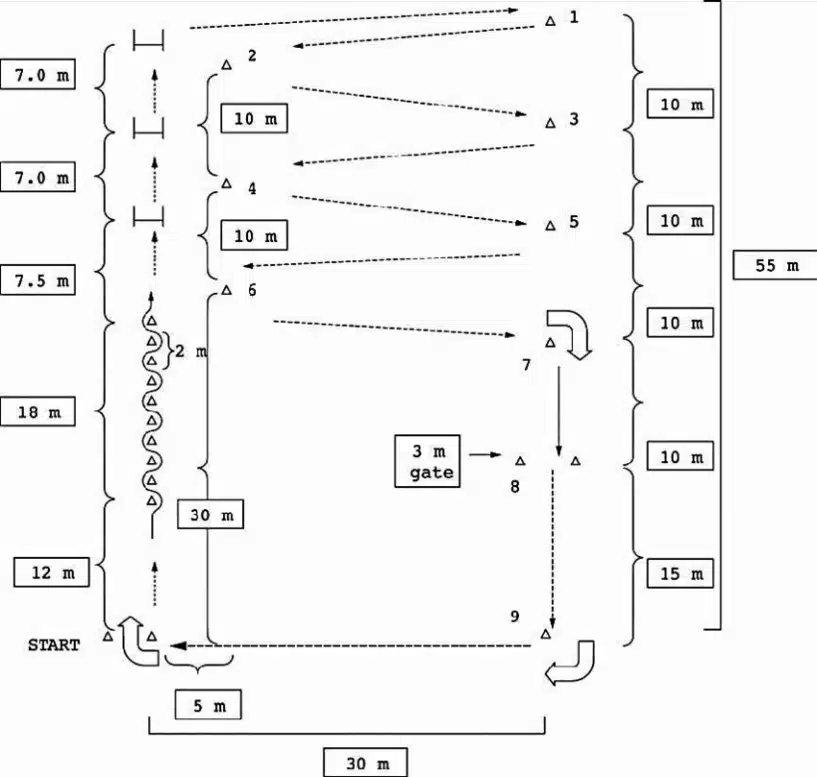
Extracted from (León Ariza et al., 2016)
Soccer Tests To Measure Different Manifestations of Strength
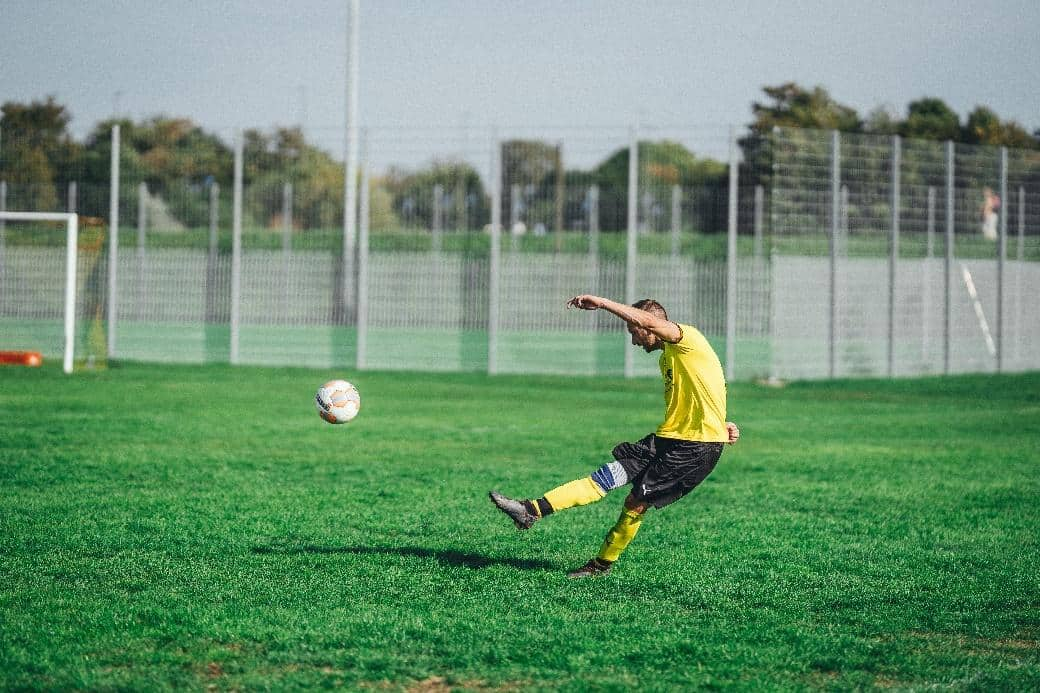
Modern soccer is becoming increasingly physical, with more collisions, more battles for aerial balls, and more game situations requiring changes in direction and speed. Strength is the physical quality that determines success in all these aspects, as it is the player’s ability to apply force that allows them to jump higher, run faster, or make a feint in milliseconds to deceive the defender and score a goal. That is why we not only need to measure endurance but also recognize that strength is equally or even more important for success in soccer.
Max-Strength Soccer Tests
Some of the tests that can be conducted in soccer players include free weightlifting tests with specific sport-related exercises such as squats, bench press, or rowing, among many others. The problem with some strength and conditioning coaches is that they continue to perform strength tests using the One Repetition Maximum (1RM), which is somewhat outdated, time-consuming, and can even lead to injuries (Hammami et al., 2013).
Strength in exercises like the squat has a significant impact on jump height, sprint speed, and performance in directional changes (Wisloff, 2004). Furthermore, a soccer player’s strength measured in the squat also indicates the player’s ability to win physical clashes in the game. It is logical that in a physical duel requiring an individual to overcome an opponent’s strength, the athlete displaying higher levels of lower body strength will succeed.
Certainly, we need to assess strength in the squat to understand the player’s condition and improve it. Instead of using maximum tests, it is highly recommended to use bar velocity measurement devices like Vitruve. With this linear encoder, we can determine the speed at which the player performed the squat, providing valuable information for our training. This data will first tell us the player’s 1RM without having to conduct traditional tests involving incremental weights until reaching a one-repetition maximum or getting close to it.
With this 1RM and the speed at which we move each load, we can see if there has been improvement over time, and for this, we only need a few minutes in the warm-up, making it feasible for daily use. The second thing we’ll know from this measurement is whether the soccer player is fatigued or recovered, a crucial aspect for injury prevention. If the player usually moves a specific load, for example, 100 kilograms in the squat at 0.5 meters per second, we need to give them rest if we notice a significant decrease in that speed. The final result of this simple squat strength test will tell us the current form of the player, whether they have improved with training, and whether they are recovered or fatigued after a match
RFD (Rate of Force Development): Jump Tests
Both vertical jump height and maximum strength levels are crucial for heading performance in soccer (Marcolin & Petrone, 2006). Players who exhibit superior jumping ability have the potential to produce headers with greater ball velocity (Marcolin & Petrone, 2006; Wing et al., 2020). Vertical jump height, generated through explosive strength, is a key factor for successfully heading the ball. That’s why the countermovement vertical jump (CMJ) can be considered one of the standout tests used in soccer clubs (Wisløff et al., 1998). There are other jump options like the squat jump (SJ), but as mentioned earlier, the soccer test should be as similar to the sport as possible. Soccer players use their arms when jumping and perform a countermovement, two elements not present in the squat jump (SJ) test, making the countermovement vertical jump (CMJ) more interesting.
To conduct this test, we need expensive laboratory force platforms or a velocity meter like the one from Vitruve. This device will provide real-time information on the jump height, as well as power and other parameters during the test. Additionally, as mentioned in the squat strength test, vertical jump height will indicate if the soccer player is fatigued from the game or a previous training session. This seemingly simple detail can be the best predictor of sports injuries.
Something as simple as performing a couple of jumps in the warm-up to measure the achieved height can help us detect fatigue in a player and prescribe rest or recovery. Failing to do so may lead to muscle injuries due to accumulated fatigue. For instance, researchers found that groin injuries occurred the following week after a decrease in strength in hip abductors (Crow et al., 2010). This indicates that we need to monitor strength levels in our soccer players frequently to determine if they need rest to prevent potential injuries.
Soccer Tests to Measure Speed, Agility, and Changes of Direction
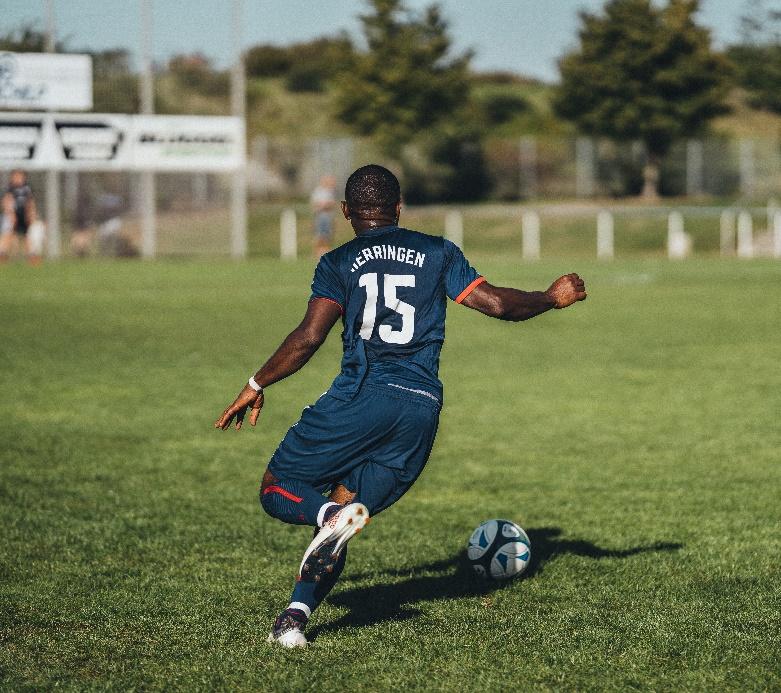
Sprint Curve Test or Bangsbo Sprint Test
Soccer requires accelerating and decelerating at near-maximum or maximum speed for durations of one to seven seconds, interspersed with short and variable rest times (Baranovič & Zemková, 2021). The player needs an aerobic base, which can be measured with the soccer tests mentioned earlier in the endurance section, but it’s the high-intensity actions that make the difference in soccer. One of the tests that can be performed is the well-known Sprint Curve Test, also known as the Bangsbo Sprint Test (J. (Jens) Bangsbo, 2011).
Its notable feature is a track consisting of three directional changes with a length of approximately 30 meters, simulating sprints in a game. The test results include the time of the fastest sprint, the average sprint time, and the fatigue index. The collected data could be compared with data from elite soccer players (J. (Jens) Bangsbo, 2011). The procedure is as follows:
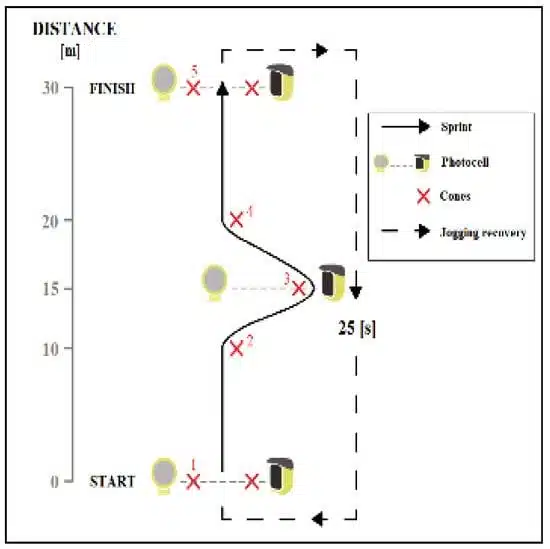
Sprint Curve Test Image: (Baranovič & Zemková, 2021)
A player starts from cone 1, with one leg placed on the starting line and the other behind the starting line. The player begins to run towards cone 5 once the examiner gives the start signal. Immediately after the start, the player runs to the second cone, where they change direction by circling cone number 2 from the outside and run towards cone number 3. After circling cone number 3 from the outside, the player runs towards the finish line. Photocells used to measure time are placed at a height of 1 m and are located on the starting line, 15 m from the starting line, and on the finish line. Once the player finishes the sprint, they must return to the starting line to begin again. The player has to complete a total of 7 sprints with 25 s of active rest (low-intensity running). After the player finishes each sprint, they have 25 s to return to the starting line. Then, the examiner counts the last 3 seconds and measures both the total time and the time spent on individual distances.
The same test can be done without a curve. In the following image, we can see the figure demonstrating how to carry it out, with the distances and the mode of executing the test being the same as used for the curved test, but in this case without changing direction or running in a curve, but instead sprinting straight.
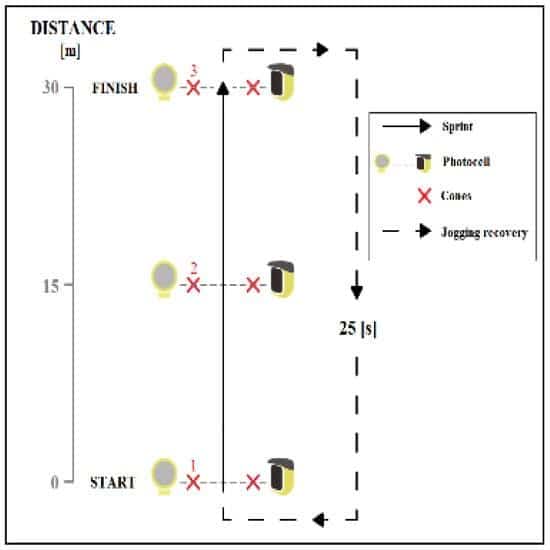
Sprint Test: (7 × 30 m) (Baranovič & Zemková, 2021)
The curved sprint test can be done with a greater number of direction changes to evaluate that crucial aspect of the player. Remember that in a soccer match, there can be between 1,200 to 1,400 changes of direction per game (J. Bangsbo, 1992; Little & Williams, 2005). In the following image, we can see the figure demonstrating how to carry it out, with the distances and the mode of executing the test being the same as used for the curved test.
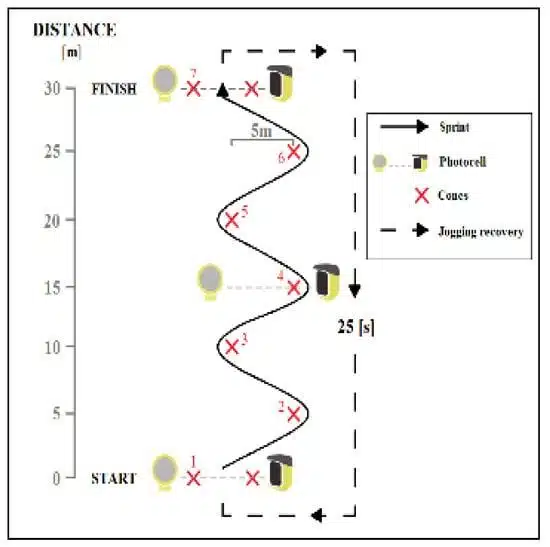
Sprint repeated test involving changes of direction. Image extracted from: (Baranovič & Zemková, 2021)
The T-Test of Agility
The T-Test is one of the main agility tests used in countless sports, also proving useful as a soccer test. The test is a combination of different sport-specific patterns such as forward, lateral, and backward movements. The T-Test of agility is commonly used to assess the ability of team sports athletes to change direction, including acceleration, deceleration, and lateral movement.
Soccer players have to run 9.14 meters forward from the starting line to the first cone and touch it with their right hand, then crawl 4.57 meters to the left to the second cone and touch it with their left hand. After that, they will crawl 9.14 meters to the right to the third cone and touch it with their right hand. From there, they’ll move 4.57 meters to the left to the middle cone and touch it with their left hand before finally returning to the starting line. The trial won’t count if the subject crosses one foot in front of the other while dragging their feet, doesn’t touch the base of the cones, or doesn’t look forward throughout the test. Get the best time out of three successful trials.
Other Soccer Tests For Injury Prevention
Isokinetic dynamometry tests have long been considered a primary method to assess muscle function and imbalances in clinical, research, and sports settings (Gleeson & Mercer, 1996). Isokinetic dynamometry should be included in soccer tests because it has been shown to detect injuries in players (Iossifidou et al., 2005). These types of tests are preferably conducted by physiotherapists and individuals with expertise in the field. Our goal is simply to mention what is recommended to measure, but professionals will determine the best soccer test for it.
Relationship Between Hamstrings & Quadriceps
Although various muscles and muscle groups can be measured, the primary application of dynamometry is to assess the relationship between the hamstrings and quadriceps. This appears relevant for soccer, as studies have shown that hamstring injuries are among the most common (van Beijsterveldt et al., 2013; Woods et al., 2004).
Imbalances Between The Right & Left Limbs
Football players may be prone to experiencing strength imbalances between the left and right limbs, as they rarely use both legs with the same emphasis (Zakas, 2006). This is likely to cause muscular asymmetry and subsequently increase susceptibility to injuries.
References
Arnason, A., Sigurdsson, S. B., Gudmundsson, A., Holme, I., Engebretsen, L., & Bahr, R. (2004). Physical Fitness, Injuries, and Team Performance in Soccer. Med. Sci. Sports Exerc, 36(2), 278–285. https://doi.org/10.1249/01.MSS.0000113478.92945.CA
Bangsbo, J. (1992). Time and motion characteristics of competitive soccer.
Bangsbo, J. (2003). The physiology of soccer–with special reference to intense intermittent exercise. Acta Physiologica Scandinavica Supplementum.
Bangsbo, J., Iaia, F. M., & Krustrup, P. (2008). The Yo-Yo intermittent recovery test: A useful tool for evaluation of physical performance in intermittent sports. Sports Medicine, 38(1), 37–51. https://doi.org/10.2165/00007256-200838010-00004/METRICS
Bangsbo, J. (Jens). (2011). Fitness testing in soccer. https://books.google.com/books/about/Fitness_testing_in_soccer_fitness_trai.html?hl=es&id=XPyUlAEACAAJ
Bangsbo, J., Mohr, M., & Krustrup, P. (2006). Physical and metabolic demands of training and match-play in the elite soccer player. Journal of Sports Sciences, 24(7), 665–674. https://doi.org/10.1080/02640410500482529
Baranovič, T., & Zemková, E. (2021). The Relationship between the Performance of Soccer Players on the Curved Sprint Test, Repeated Sprint Test, and Change-of-Direction Speed Test. Applied Sciences 2021, Vol. 11, Page 5355, 11(12), 5355. https://doi.org/10.3390/APP11125355
Bradley, P. S., Sheldon, W., Wooster, B., Olsen, P., Boanas, P., & Krustrup, P. (2009). High-intensity running in English FA Premier League soccer matches. Journal of Sports Sciences, 27(2), 159–168. https://doi.org/10.1080/02640410802512775
Carling, C., Reilly, T., & Williams, A. M. (A. M. (2009). Performance assessment for field sports. Routledge. https://www.routledge.com/Performance-Assessment-for-Field-Sports/Carling-Reilly-Williams/p/book/9780415426855
Castagna, C., Abt, G., & D’Ottavio, S. (2005). Competitive-level differences in Yo-Yo intermittent recovery and twelve minute run test performance in soccer referees. Journal of Strength and Conditioning Research, 19(4), 805–809. https://doi.org/10.1519/R-14473.1
Crow, J. F., Pearce, A. J., Veale, J. P., VanderWesthuizen, D., Coburn, P. T., & Pizzari, T. (2010). Hip adductor muscle strength is reduced preceding and during the onset of groin pain in elite junior Australian soccer players. Journal of Science and Medicine in Sport, 13(2), 202–204. https://doi.org/10.1016/J.JSAMS.2009.03.007
Ekblom, B. (1986). Applied physiology of soccer. Sports Medicine (Auckland, N.Z.), 3(1), 50–60. https://doi.org/10.2165/00007256-198603010-00005
Gleeson, N. P., & Mercer, T. H. (1996). The utility of isokinetic dynamometry in the assessment of human muscle function. Sports Medicine (Auckland, N.Z.), 21(1), 18–34. https://doi.org/10.2165/00007256-199621010-00003
Goes, F. R., Kempe, M., & Lemmink, K. A. P. M. (2019). Predicting match outcome in professional Dutch soccer using tactical performance metrics computed from position tracking data. EasyChair Preprints, 993. https://doi.org/10.29007/4JJB
Hammami, M. A., Ben Abderrahmane, A., Nebigh, A., Le Moal, E., Ben Ounis, O., Tabka, Z., & Zouhal, H. (2013). Effects of a soccer season on anthropometric characteristics and physical fitness in elite young soccer players. Journal of Sports Sciences, 31(6), 589–596. https://doi.org/10.1080/02640414.2012.746721
Herold, M., Kempe, M., Bauer, P., & Meyer, T. (2021). Attacking Key Performance Indicators in Soccer: Current Practice and Perceptions from the Elite to Youth Academy Level. Journal of Sports Science & Medicine, 20(1), 158. https://doi.org/10.52082/JSSM.2021.158
Iossifidou, A., Baltzopoulos, V., & Giakas, G. (2005). Isokinetic knee extension and vertical jumping: are they related? Journal of Sports Sciences, 23(10), 1121–1127. https://doi.org/10.1080/02640410500128189
León Ariza, H. H., Ramírez Villada, J. F., & Sánchez Jiménez, A. (2016). Validación del test de Hoff en futbolistas universitarios a 2600 metros sobre el nivel del mar. Agora Para La Educación Física y El Deporte, 1, 89–98. https://uvadoc.uva.es/handle/10324/23807
Little, T., & Williams, A. G. (2005). Specificity of acceleration, maximum speed, and agility in professional soccer players. Journal of Strength and Conditioning Research, 19(1), 76–78. https://doi.org/10.1519/14253.1
Marcolin, G., & Petrone, N. (2006). A METHOD FOR THE PERFORMANCE EVALUATION OF JUMPING HEADERS IN SOCCER. ISBS – Conference Proceedings Archive. https://ojs.ub.uni-konstanz.de/cpa/article/view/219
Nicholas, C. W., Nuttall, F. E., & Williams, C. (2000). The Loughborough Intermittent Shuttle Test: a field test that simulates the activity pattern of soccer. Journal of Sports Sciences, 18(2), 97–104. https://doi.org/10.1080/026404100365162
Rampinini, E., Impellizzeri, F. M., Castagna, C., Azzalin, A., Bravo, D. F., & Wisløff, U. (2008). Effect of match-related fatigue on short-passing ability in young soccer players. Medicine and Science in Sports and Exercise, 40(5), 934–942. https://doi.org/10.1249/MSS.0B013E3181666EB8
Rampinini, E., Sassi, A., Morelli, A., Mazzoni, S., Fanchini, M., & Coutts, A. J. (2009). Repeated-sprint ability in professional and amateur soccer players. Applied Physiology, Nutrition and Metabolism, 34(6), 1048–1054. https://doi.org/10.1139/H09-111/ASSET/IMAGES/H09-111IE62H.GIF
Ramsbottom, R., Brewer, J., & Williams, C. (1988). A progressive shuttle run test to estimate maximal oxygen uptake. British Journal of Sports Medicine, 22(4), 141–144. https://doi.org/10.1136/BJSM.22.4.141
Stølen, T., Chamari, K., Castagna, C., & Wisløff, U. (2005). Physiology of soccer: an update. Sports Medicine (Auckland, N.Z.), 35(6), 501–536. https://doi.org/10.2165/00007256-200535060-00004
Straume-Naesheim, T. M., Andersen, T. E., Dvorak, J., & Bahr, R. (2005). Effects of heading exposure and previous concussions on neuropsychological performance among Norwegian elite soccerers. British Journal of Sports Medicine, 39(suppl 1), i70–i77. https://doi.org/10.1136/BJSM.2005.019646
Svensson, M., & Drust, B. (2005). Testing soccer players. Journal of Sports Sciences, 23(6), 601–618. https://doi.org/10.1080/02640410400021294
van Beijsterveldt, A. M. C., van de Port, I. G. L., Vereijken, A. J., & Backx, F. J. G. (2013). Risk factors for hamstring injuries in male soccer players: a systematic review of prospective studies. Scandinavian Journal of Medicine & Science in Sports, 23(3), 253–262. https://doi.org/10.1111/J.1600-0838.2012.01487.X
Wing, C. E., Turner, A. N., & Bishop, C. J. (2020). Importance of Strength and Power on Key Performance Indicators in Elite Youth Soccer. Journal of Strength and Conditioning Research, 34(7), 2006–2014. https://doi.org/10.1519/JSC.0000000000002446
Wisloff, U. , et al. (2004). Strong correlation of maximal squat strength with… https://www.iat.uni-leipzig.de/datenbanken/iks/bvdg/Record/3037555
Wisløff, U., Helgerud, J., & Hoff, J. (1998). Strength and endurance of elite soccer players. Medicine and Science in Sports and Exercise, 30(3), 462–467. https://doi.org/10.1097/00005768-199803000-00019
Woods, C., Hawkins, R. D., Maltby, S., Hulse, M., Thomas, A., & Hodson, A. (2004). The Football Association Medical Research Programme: an audit of injuries in professional soccer–analysis of hamstring injuries. British Journal of Sports Medicine, 38(1), 36–41. https://doi.org/10.1136/BJSM.2002.002352
Zagatto, A. M., Papoti, M., Da Silva, A. S. R., Barbieri, R. A., Campos, E. Z., Ferreira, E. C., Loures, J. P., & Chamari, K. (2016). The Hoff circuit test is more specific than an incremental treadmill test to assess endurance with the ball in youth soccer players. Biology of Sport, 33(3), 263. https://doi.org/10.5604/20831862.1201913
Zakas, A. (2006). Bilateral isokinetic peak torque of quadriceps and hamstring muscles in professional soccer players with dominance on one or both two sides. The Journal of Sports Medicine and Physical Fitness, 46(1), 28–35. https://europepmc.org/article/med/16596096

